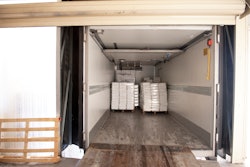
The world of frozen food shipping has shifted significantly over the last few years, as many frozen food companies look to inventory consolidation to help gain an advantage in a growing but changing market.
A study by Grand View Research estimates that the frozen food market will reach $72.98 billion by 2024, and yet, while the market for frozen foods is growing, order sizes aren’t. There are several contributing factors to this trend, including changing consumer demands and e-commerce’s growing presence, in addition to greater retail restriction and harsher penalties. However, the right consolidation model can help shippers achieve greater supply chain efficiency and, ultimately, reduce costs and improve service.
Changing Consumer Demands
Even as recently as five years ago, people turned to frozen foods for many meals—frozen waffles for breakfast, microwave meals for a quick office lunch, even pre-mixed meals for family dinner. But that’s changing. Today, convenience is king, and healthy options aren’t far behind on consumers’ wish lists.
On-the-go packaging has never been more popular. Millennials and young families have jam-packed schedules, which means food needs to be ready fast. But unlike previous generations, today’s consumers still expect their grab-and-go options to be healthy ones. More than ever before, consumers are making thoughtful food choices based on ingredients, source, company story and perceived health benefits. And frozen foods that are capitalizing on this trend—especially disruptors—are seeing growth.
Meatless meats, gluten-free bread and low-calorie ice cream are just a few of the products that are gaining popularity across the United States—due in large part because they fit into the healthy options that consumers crave.
E-commerce Drives Competitors
Startup companies trying to meet the need for healthy, convenient foods are sprouting up and taking their fair share of the market every day. And these disruptors can quickly gain regional and national footholds, thanks to the rising popularity of e-commerce.
Online shopping that comes with two-hour delivery windows has blown apart old expectations of shopping. When you can sit on your couch and pick out a specialty brand of ice cream to have delivered, why would you drive to the store only to be able to pick from one or two brands?
The demand for more product diversity in stores to compete with online offerings means more competition for shelf space. And as retailers try to provide what consumers want, they’ve expanded their inventory to include more brands. To manage this, they’re placing smaller orders and adding deliveries. A retailer that used to place a 30-pallet order every week may now require four pallets every day of the week instead, because they’re working with three times as many companies all selling the same product.
Retailer Requirements and Penalties
Frozen transportation isn’t all about the transportation costs anymore. Now your soft costs can have a real impact on margins. When you fail to meet retailer requirements, you can expect to pay.
Retailer fees for failing to stay compliant are rising; some retailers have even started fining based on the cost of the goods. And for the first time, paying a little extra on transportation costs to improve service and reliability levels might actually save your company money.
And these fines are not static. It seems that every month retailers send out new fees, fines or compliance structures. Especially impacted by these costs are third-party logistics providers (3PL), who’ve rapidly seen more stringent on-time expectations and narrowing delivery windows.
Beyond just being on time for delivery appointments, retailers also are shrinking those delivery windows to make time for the deliveries they’re expecting from more brands. The ever-changing expectations make meeting them even more difficult for shippers that need to deliver even more often.
Just-in-time Environment
Frozen food shippers are living in a just-in-time (JIT) world, and it changes everything. Plain and simple. It no longer matters that your frozen product has a year-long shelf life if the retailer you’re delivering to expects new deliveries every week.
Luckily, frozen food companies have it slightly easier than fresh food companies when it comes to transporting goods and still meeting retailer requirements. Transporting consolidated frozen products can be simpler than refrigerated products because freshness isn’t at stake. Trucks are kept in a frozen state, and as long as the truck maintains one set temperature, the products aren’t likely at risk for going bad. Not to mention that refrigerated products have varying temperature windows, which can make consolidation across products more difficult—although not impossible.
Frozen Consolidation Shipping
The right consolidation model is one way to support frozen orders and achieve greater efficiency across your entire supply chain, leading to reduced costs and improved service to retailers. When implementing a strong consolidation strategy, there are several things to keep in mind:
- Inventory levels can be used to your advantage. JIT requires tight inventory control—at every step in the process. However, frozen food companies often miss the opportunity to leverage inventory levels; they tend to spread inventory out across multiple locations that are near current retailers. However, this is a strategy for highly perishable freight and less perishable foods often receive fewer benefits from this strategy. Instead, a central inventory location allows you to leverage volumes and drive inventory costs down, without sacrificing product quality.
- Do-it-yourself frozen consolidation requires skill. Consolidating frozen foods relies on large volumes to make it successful—especially when retailer expectations are so high. When retailers expect deliveries every week and in a small window, building your own loads can be extremely difficult.
Trying to send one truck that’s only 60 percent full isn’t cost-effective. Then further expecting it to make multiple retail stops in a row and hit every delivery appointment isn’t going to work well. A provider that has several customers all with small orders that are shipping to the same retail location can make a single consolidation appointment and be far more successful.
Not All Providers Are Equal
Maintaining a central inventory location relies on nationwide provider coverage; regional carriers often can’t compare. A provider with strong retail relationships that already is regularly shipping through these channels will have the most to offer. At the bare minimum, a quality frozen foods consolidator should offer the following:
- Understand requirements, and offer a fair rate. Your provider should offer a fair rate paired with quality service. Make sure your provider understands all retailer requirements to avoid unnecessary fees and fines. A cheap rate that delivers late and results in fees isn’t a fair rate anymore.
- Operate with consistency. Even the largest retailer will let you choose what day to deliver, but they then expect you to consistently deliver on that day and in a predefined window. Frozen consolidators that have high enough volumes can help match production cycles and transit times to delivery expectations—tender on this day, ship within this window, and deliver on this day as planned.
- Provide visibility to orders and key performance indicators (KPIs). The concept of delivering both in full and on time is a hot topic across all supply chains—especially for temperature-controlled foods. The only way to achieve it consistently is with clear visibility. Visibility seems like a self-explanatory requirement, yet it still is a challenge for some providers to deliver. You should know exactly where each of your consolidated orders are in transit—whether they’re waiting pickup, in motion or meeting a delivery window.
If the frozen food consolidators you’re looking at (or are already working with) aren’t able to provide this level of service, consider finding a provider that can.
Room for Innovation
The growth of the frozen food market shows frozen foods are by no means disappearing. But the same changes that are affecting the retail sector at large are influencing frozen foods.
What the space looks like in the future is hard to predict, but it’s safe to say that more products will try to capitalize on the “convenience” and “healthy” aspects that today’s consumers want and demand. Those who are truly successful in the space will have supply chains that can keep their profits as profits—rather than paying them out as retail fees and fines.


















